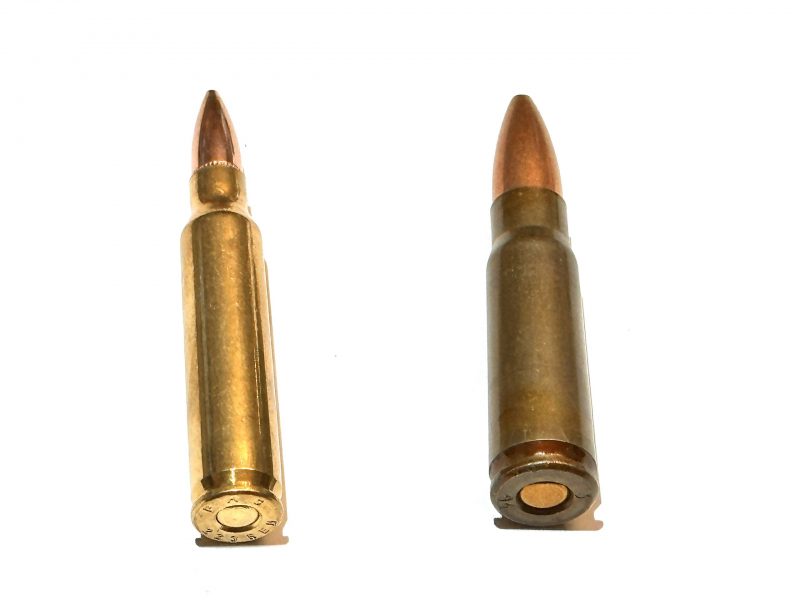It doesn’t matter if it’s for hunting, home defense, CCW, or competition shooting, picking out a gun can be overwhelming. There have been times when I knew what type of gun I wanted to buy, but after heading to the gun store, I would get lost in all the options. I wish I could say that was the hard part and the decision is now over. Well, it’s not. Now you need a holster, optic, scope, backup sights, and let’s not forget… ammo. If you think selecting a gun is hard, try picking out ammo.

Ammo comes in all shapes and sizes. Some types of ammo are more popular than others which can dictate how many choices there are. If you buy an 8mm hunting rifle, there may only be a few selections to pick from. But if you are looking at 9mm, 5.56 NATO, or some other popular caliber of bullet, there will be lots of options. On the box, they will list the caliber and grain, but there may also be some designations like “FMJ”, “JHP”, “HP” and more. Ammo is available for training, hunting, and self-defense. Let’s break down each type of ammo you see on the shelves and what all those designations mean.
Types of Ammunition
Ammunition is generally split into three categories: shotgun, handgun, and rifle. Most of the time, gun stores will sort the ammo by these categories so if you are looking for .45 ACP ammo you won’t find it next to the .308 ammunition. As mentioned above, each caliber may have several types, and this is where it can become confusing if you are new to the ammo world. There is specific ammo for hunting and specific ammo for self-defense. Centerfire ammo has a primer in the back that ignites when struck by a pin or hammer. With rimfire ammunition, the hammer must crush the edge (rim) of the casing to ignite the powder. The most popular type of rimfire ammo is .22 and .17 caliber.
Full Metal Jacket
FMJ ammo, often referred to as ball ammo, is the cheapest ammo of them all. Normally used for training and target practice, it consists of a soft metal core which is normally lead, with a harder outer cover (jacket). FMJ ammo started being used as auto-loading guns became popular. A solid lead bullet would get deformed during the loading process, making it jam. The harder jacket keeps the shape of the bullet intact during this process. It also helps reduce the amount of buildup in the barrel. Because of the hardness of the jacket, an FMJ round can over-penetrate some targets. While great for targets, this can be dangerous for self-defense.

Hollow Point and Jacketed Hollow Point
As the name implies, a hollow point bullet has a hollow spot in the front of it. This helps the bullet stop faster and not over-penetrate. The hollow point on the front of the bullet stops faster by expanding into a mushroom shape, making the hole larger as it enters the target. Hollow-point bullets (see photo below) are the most common for self-defense purposes. Jacketed hollow point ammo is a hollow point with a harder covered jacket over the outer portion just like a full metal jacket. Some JHP ammo has cuts on the end to help the jacket spread apart when it hits a target. Some of the more modern types of JHP ammo have plastic or gel inside the hollow portion.

Steel Case Ammo
One issue I will point out is the difference between brass and steel case ammunition. Steel case ammo is cheaper than brass, but in some cases, the savings may not be worth it. Guns like the AK-47 were made to shoot steel case ammo but some were not. The Germans used steel case ammo in most of their weapons in WWII and the US made steel case .45 ammo to help lower the cost of production. A lot of modern guns, however, have issues with steel case ammo. This is mostly because of the tighter tolerances with today’s manufacturing standards. Steel case ammo is extremely dirty which can make a gun more prone to malfunctioning.

Another issue is that most weapons are made to shoot brass ammo, which is easier on weapons because brass is softer than steel. Even though the steel on the gun is harder than the steel used to make the shell casing, it can wear down the extractor much faster than it does with brass. It doesn’t mean you can’t shoot steel ammo from your AR-15 or Glock handgun, just be prepared to clean them more. I have shot steel-cased 9mm from a Glock before and had no issues. But I have also had several AR-15s start to malfunction after several hundred rounds of steel casing were fired through them during training events.
Summary
Aside from all the different types of ammo, there are several other things to watch for too. The grain of the bullet refers to its weight. A bullet’s weight can affect how accurate it is and how much knock-down power the bullet has. Each gun will like a particular grain of bullet better. This will depend on the length of barrel, the twist rate, etc. Some firearms will come with recommendations from the manufacturer as to what type of ammo shoots the best in that gun.
Other times, you may have to try a few different types and weights to see what works best. The process of finding and buying ammo may be intimidating. But once you learn what type of ammo you want for each gun, you can begin the fun process of racing to the store to buy that box of ammo before it flies off the shelf.


